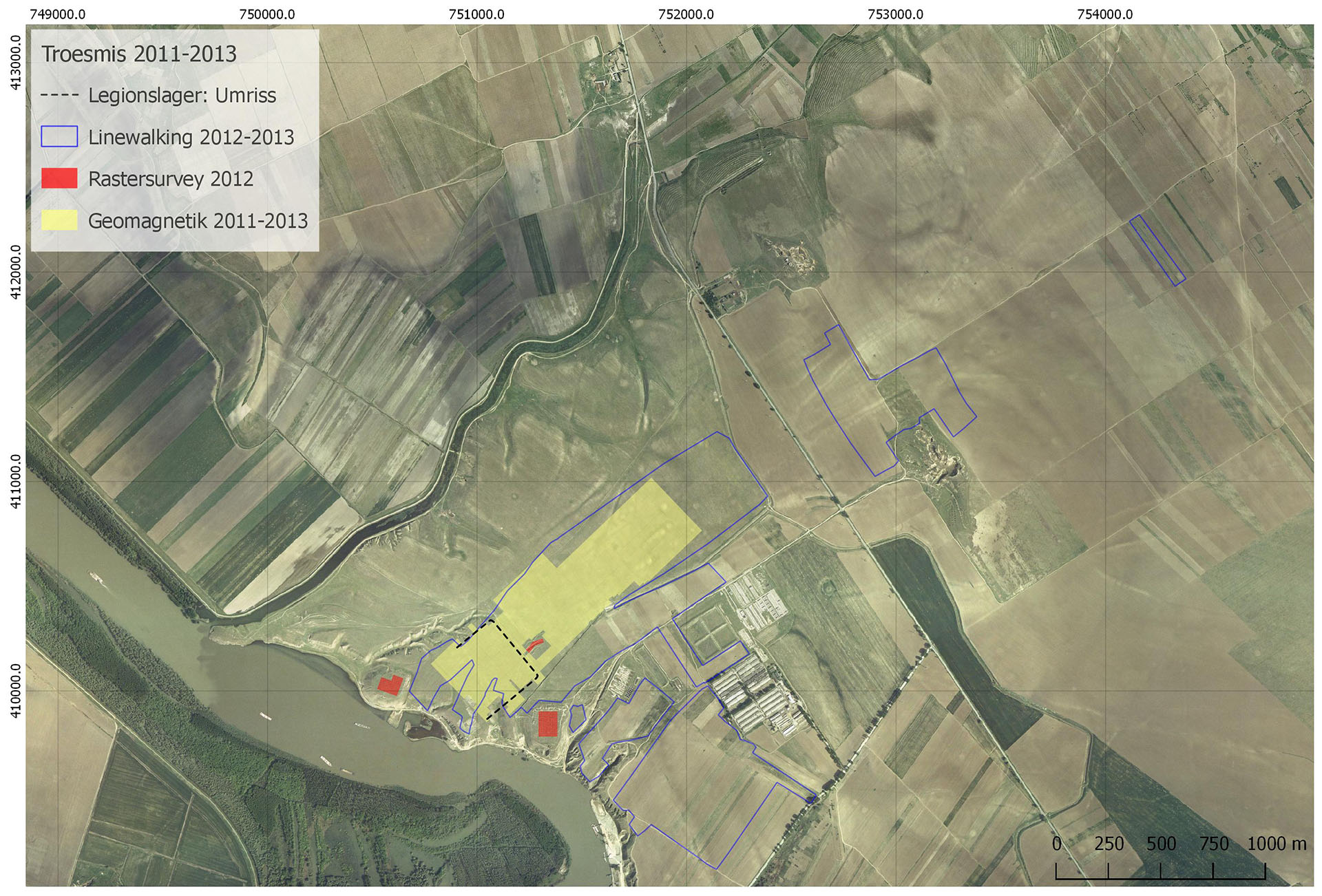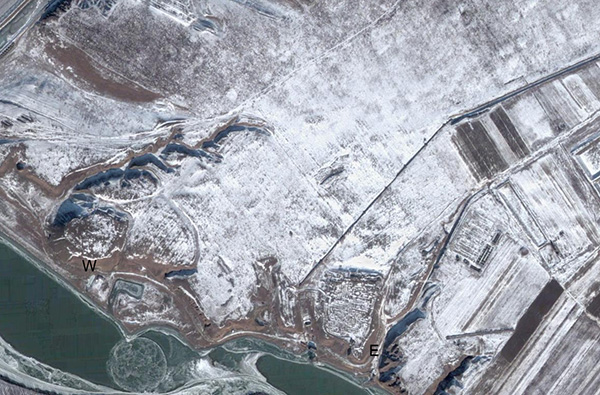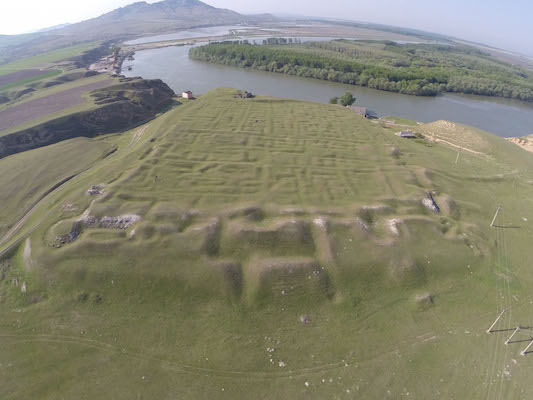Troesmis: Roman Legionary Camp – Municipium – Late Antique and Byzantine Border Fortress
Since 2011 the OeAI has participated in a cooperative project with the Archaeological Institute of the Romanian Academy of Sciences, focusing on the settlement-archaeological transformation processes along the Lower Danube in antiquity. At an exposed border site such as Troesmis, the changes in the settlement spaces and living environments from the 2nd–6th century should be investigated in an exemplary fashion, applying innovative archaeological methods of documentation and evaluation (digital documentation of evidence, photogrammetry, geophysical prospection and geo-information technology).
Troesmis (Igliţa), located in the north-west of the Dobruja, occupied a key strategic position on the Roman Danube limes. The Roman-Byzantine settlement lay on the right steep slope of the Danube, approximately 15 km south of today's town of Măcin and 4 km north of the village of Turcoaia (jud. Tulcea). The extensive ruined site, which is dominated by two remains of fortification walls that are still visible today, extends from the Danube towards the east, as far as the foothills of the Măcin mountain range.
We know from historical sources that, during the mid-imperial period, probably from the Trajanic era up until the Marcomannic wars, the Legio V Macedonica was stationed in Troesmis. Although an older Getic-Odrysian settlement was mentioned already by Ovid in the »Epistulae ex Ponto« (4, 9, 78–79), nevertheless nothing is known archaeologically about pre-Roman or early imperial Troesmis.
In the later years of the reign of Marcus Aurelius, municipal status was bestowed on Troesmis. The extent of the mid-imperial settlement on the surrounding fields, on which numerous scattered finds (architectural blocks, architectural ceramics, pottery vessels) continually come to light, is not yet documented. According to the most recent estimates, the settlement area ought to have comprised approximately 50 ha. A number of streets, at least one underground water conduit (›Trajan's wall‹), and a number of tumulus-like structures – presumably tombs – can be seen on aerial photographs and in the relief of the terrain on fields immediately before the settlement.
The construction of the so-called eastern fortification has been dated to Late Antiquity due to considerations of its architectural typology and criteria of fortification techniques. It was already extensively excavated in the second half of the 19th century, whereby the course of the breastwork with a number of towers and the main gate, as well as large areas of the inner construction, were documented. Essentially, only parts of the curtain wall of the western fortification, located ca. 700 m distant, are known. Numerous inscriptions dating to the 2nd and 3rd centuries were built into both fortification sites as spolia, providing important information regarding the administrative and settlement structures of mid-imperial Troesmis.
A series of clues indicate that the western fortification was only used during the Byzantine period. In addition to the settlement activity, attested by small finds, pottery, and coins from the 10th to the 13th centuries, rescue excavations in 1977 on the plateau between the two fortifications brought to light numerous – probably Mediaeval – inhumation burials. These observations, which are to be interpreted in the context of the redevelopment of the Byzantine border defence along the Lower Danube, also correspond with the last-known reference to Troesmis in the written sources by Emperor Constantine VII (Porphyrogenitus) (De Them. 47, 17).
During the field campaign of 2011, the still visible architectural remains of the eastern fortification, the western fortification and the imperial era Canabae legionis were documented. In 2012 and 2013, a surface survey in the core area of the Roman-Byzantine city was carried out: the extent of the settlement could be defined by means of Line Walking. Over a surface of ca. 2 ha., a grid survey was carried out in the western fortification (middle Byzantine), the eastern fortification (Late Antique) and in the imperial Canabae, where the surface material was gathered together in the area of an excavation site open since the 1970s.
In addition to the mapping of the remains of the Roman water conduit, a team from the University of Innsbruck (Institute for Archaeology) carried out extensive geomagnetic measurements which resulted in significant information about the Roman settlement of the 2nd and 3rd centuries, including the localisation of the camp of Legio V Macedonica. In the meantime, the large settlement spaces of the legionary camp/municipium, Canabae, and burial grounds can be clearly distinguished. With the aid of geomagnetic applications, concrete conclusions regarding the structure of the development of the Canabae, as well as the tumulus burial grounds north-east of the legionary camp, are attainable. It is now thereby possible, for the first time on the Lower Danube limes, to better understand the environment of the military camps which are generally favoured sites of investigation. The evaluation of the artefacts collected on the surface also permits the reconstruction of the relocation of the settlement from a chronological long-term perspective, extending from the imperial period (2nd/3rd century AD) over Late Antiquity and up until the Middle Ages. By these means, the extent of the Middle Byzantine settlement of the 10th to the 13th century in particular, which was fortified multiple times, can be very well understood.
Principal Investigator
- Christina Alexandrescu (Institutul de Arheologie »Vasile Parvan«)
Cooperations
- Academia Romana (Institutul de Arheologie »Vasile Parvan«)
- Universität Innsbruck (Institut für Archäologien)
Duration
since 2010
Funding
- Jubiläumsfonds der Oesterreichischen Natrionalbank Nr. 16365 (2015/2016)
- OeAW-OeAI


